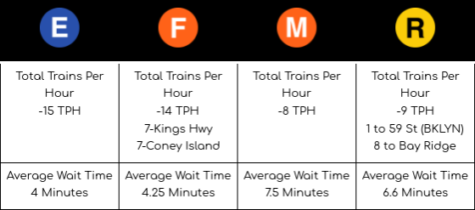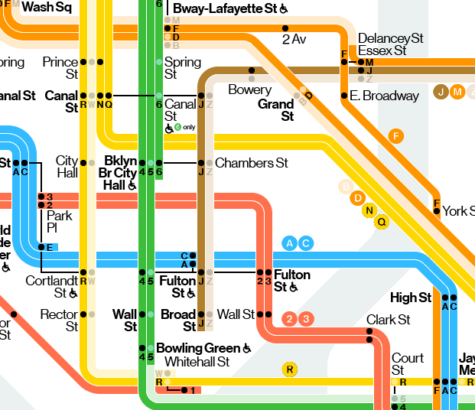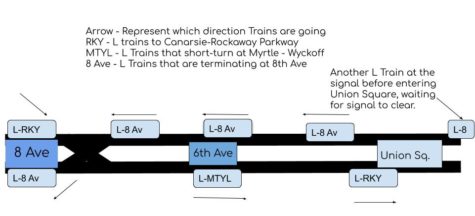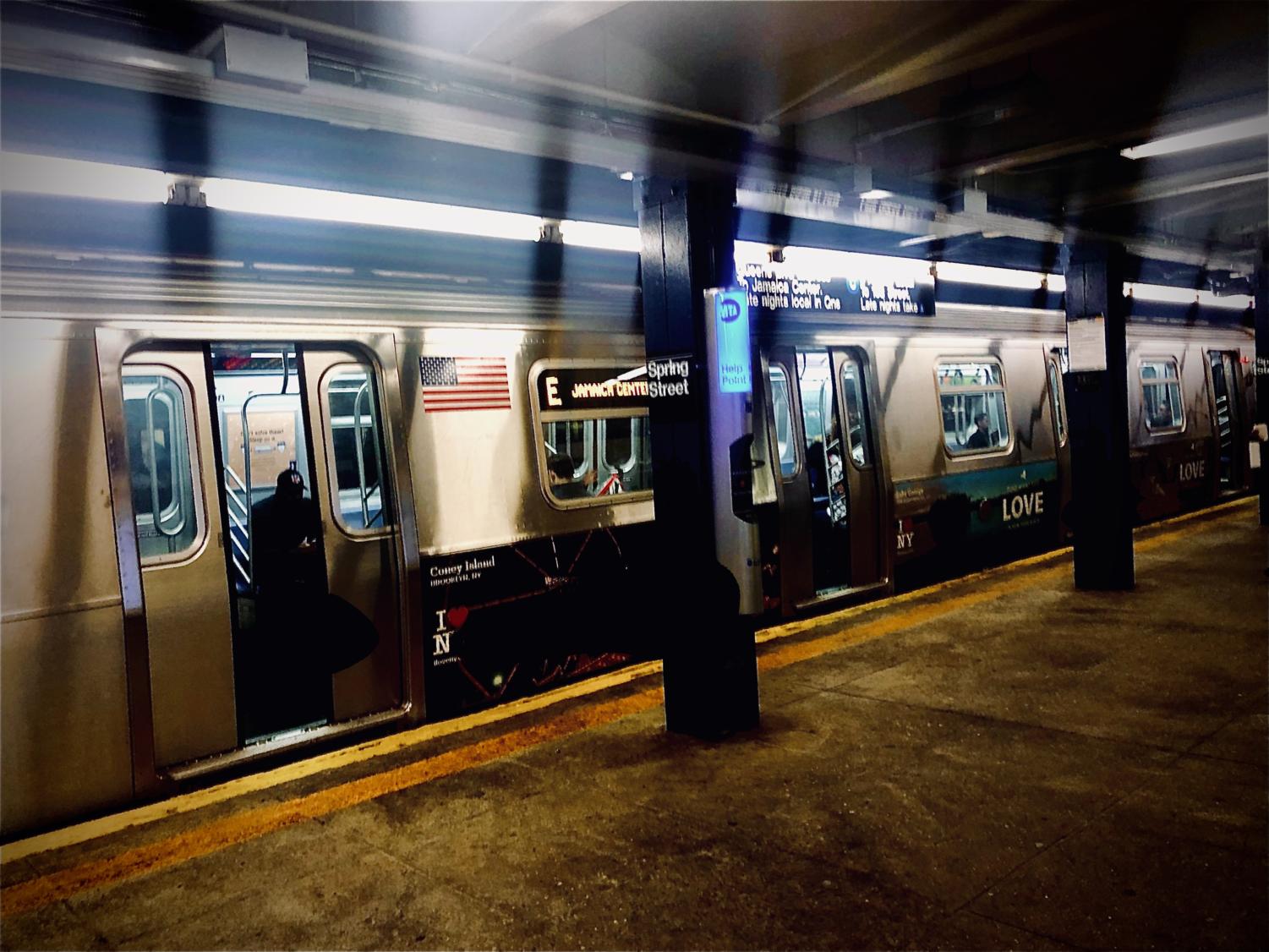The foresight of the subway
November 7, 2019
You’re late for School. You run into a hurry to your local subway station. Then you see an express train, that just so happens to arrive at the same time as you do. As you enter the train, you breathe a sigh of relief. The train leaves, and you’ll be at school in no time.
Then…
It stops…
And you hear:
Ladies and gentlemen, we are being held momentarily by train traffic ahead of us, please be patient
Then, you see a local train, the same one you could have waited for if you had wanted to wait an extra 2 minutes on the platform. The wait feels like an eternity and when the train finally does move, it goes crawling like a grandmother crossing the street.
It is no lie that the subway has been worsening. According to a report done by the New York Times, The (F) train, for example, have a miserable on-time rate of about 50 % — the lowest in the system.
Most of the BMT and IND lines have suffered through more and more train delays on average. The IRT (number lines) other lines like the 6 train have been given service reductions, losing 5 trains in regular service. However, the on-time rate for the 6 train jumped to 72 % in January, which change up from 52% prior to the change.
The trade-off for less service for better on-time performance is an issue that many would argue that lessening train service would mean that people in underground stations will feel the heat in the summer, and elevated passengers will succumb to the elements when it’s not sunny, not windy, and not 68 degrees. The trade-off is that on lines like the 1,6,7 and the L, there would be faster commutes as these lines don’t share tracks with other subway lines. Lines like the A and D, where both lines share tracks between 145-59th Street, will see a lot of change if one schedule is changed as one impact on the D trains schedule, for example, would also have an impact on the A, B, And N lines.
The Ups and Downs of a Trunk Line.
The fact of the matter is that in order to have faster commutes with fewer wait times, Trains can not share tracks whatsoever. That’s easier said than done. In New York, the main point of different subway lines sharing tracks and in most cases in the four subway filled boroughs, trunk lines, are to allow people to have the option of both Local and Express services that both complement each other, and distribute passengers into their Manhattan Mainlines that bring people into different parts of the city.
For Example, the Queens Boulevard Line. (QBL) Home of the E/F/M/ And R trains, distribute passengers from Northern and Southeastern Queens into three different Manhattan trunks. The Broadway Line, (R) via 60th Street, 6th Ave Line (M) Train via 53rd Street and the (F) train via 63rd Street, and the 8th Ave Line (E) also via 53rd Street. Of course, we all know that most passengers don’t really take local trains. Hence, the R and M Trains don’t start at Jamaica – They start at Forest Hills for this exact reason.
Also, the reason why the E and Fs don’t start at Forest Hills, The demand isn’t there for express trains to start and end at Forest Hills. During the 80s and 90s when they’re where were 2 express trains scheduled to start at Forest Hills, they had ran empty, whilst mainline express trains from Jamaica were at max capacity even before getting to Forest Hills. It’s a supply and demand issue.
In a survey sent out to the iSchool community, when asked about service wait times on the Queens Boulevard line, half of the respondents said that they waited more for a local train to arrive and half said that an express train took longer to arrive. However, the QBL Timetable leaned to showing how the effects of scheduling have an impact on us, the commuter
During the hours of 8:01-9:01 time slot, the following trains had arrived at Jackson Heights-Roosevelt Av Bound for Manhattan:
The Link to the full data is available here.

The average wait for any train would be around 1.3 minutes At Jackson Heights-Roosevelt. Combining the E and F Train service would mean that during that hour, 29 express trains would arrive and depart, while 17 Local trains (combined M and R totals) would too, serve the station.
iSchoolers who regularly use the QBL about this had confirmed what the data suggested: “Local Trains just don’t make sense, unless if you live at a local stop, and even then people would still transfer to an Express just because it is the faster choice”
If the (E) were a local, “Well, it depends to be honest, if the train were local, then it would be more if I was willing to wait on a local if I was on a rush then I would’ve just taken an express, Either way as long as I can get to Spring.”
However local passengers do suffer more when it comes to wait times, as they can wait for an average of 3 and a half minutes for any train between Jackson and Queens Plaza. However, that wait time will be longer if passengers take a local into Manhattan as they can be stuck waiting 6.6 minutes for the R, To even 7 and a half minutes If they were to wait for the M.
It isn’t hard to find that despite serving the same areas, more people would be inclined on taking the Express if it arrives fast and stops less. That is the point of Express and Local lines, to complement one another, but what is done here isn’t complementing both services, it’s only causing an imbalance where the Express trains get too crowded and the Locals get too empty.
Hence why the trunk model has only worked in Manhattan. As lines are able to move more freely through the city, as both local and express lines go their own way in the outer boroughs, Trunk lines like the QBL or the Eastern Parkway line aren’t able to replicate this as the lines that are mainly used aren’t the ones that run closest to them, but rather the lines that are able to run 24/7.
System Imbalances

Shown here, MTA Weekender Dulled out, M train after Delancey/Essex, B Train Completely, W Train Completely, Z Train Completely, 5 Train after Bowling Green
6th Avenue Line
Imbalances are actually quite common on the subway. The 6th Ave line, on weekdays, carries the B, D, F, M lines. However, most of the demand that is brought into the 6th Avenue line is for QBL Express and Culver local trains (F), and for Express service onto the Concourse and West End lines (D). On weekends, Prior to the L Train Shutdown, the D and F trains were the only two lines that ran on 6th Ave 24/7. Mainly due to people not needing a local option to Queens or the Bronx, and the lack of demand for Weekend Brighton Express trains.
Now the M train joins in on weekends, but short-turns at 96th Street-2nd Avenue as the line is meant to shuttle Weekend Canarsie Line riders into Midtown without the huge 20-minute wait between Manhattan and Brooklyn that they would have to endure otherwise on the L.
The huge percentage of people who also use the 7th and 8th Avenue lines also take a hit as they both serve Times Square, The PABT, Penn Station and MSG. Whilst the 6th Ave line’s only true landmark would be the Rockefeller Center area. The 7th Ave line also takes a toll on both the 6th and 8th Ave Lines, as the 1 Train stops 3 times in a high demand area while the C, E, F and M only stop at 23rd Street.
Lexington Avenue Line
Imbalances not only impact how people get to where they need to go but also impact how a whole line may operate. The Lexington Avenue line, for instance, operates with the high demand of the 4 and 6 trains, While the 5 is only there to “assist” with Express service on Lexington. Imbalance in service demand is shown when the 5 is in direct competition with the 2 train.
The 2 train is the only line that receives a higher amount of ridership between the Bronx and Manhattan, Partly due to it being the only West Side line to be operating in the Eastern Bronx. The 4 and the B/D are able to work close to one another is due to how the lines run in Manhattan. The 4 brings passengers to/from into the East Side to the Western Bronx Via Jerome. While the B/D takes commuters into Central Harlem and the Westside from Concourse.
The usage of the 5 Train is light due to the fact the WPR Line has had full service 24/7 to the Westside. The need for East Bronx to Lex service is only ever used during Rushed hours and even then, stations like 3rd Avenue suffer from many who take the 5 Express but switch over to the already overwhelmed 2 train.
The Canarsie Line has had major growth in ridership through the last several years, Williamsburg and Bed-Stuy being hotspots of the new Brooklyn. Anyone and I mean anyone can go to Union Square and wait for an 8th Avenue-bound L Train during the Morning Rush. Only to see nearly 6 Subway cars full of people exit the train all in one go. It is honestly so fascinating to see how the old R143 Cars start to shift as they recalibrate and fall back and balance at several tons of people.
The Canarsie Line in a 21st Century New York
The L train Shutdown, when originally planned, would have knocked out the Canarsie line from operating in Manhattan for 18 months starting in April of 2019, That plan was scrapped when it was announced that the shutdown of the Canarsie tunnels had been reduced to Partial only during Overnight and Weekends, although this has put a strangle on the Canarsie lines’ survivability. According to Inverse “50,000 riders take the L train from 8th Avenue to 1st Avenue in Manhattan.” Whilst the rest of Canarsie has seen a “236 %” Growth in overall customers between 8th Ave and Rockaway.
As “The northern Brooklyn neighborhoods of Williamsburg, Greenpoint, and Bushwick have exploded with growth over the last decade as artists, hipsters, and now Yuppy families moved in search of lower rents and more space,” According to vanshnookenraggen. This moves on to my last point regarding the Subway, The competence of the L Train in a 21st Century Brooklyn.
The L train shutdown has not only shown the negative effects of putting off repairs, long enough to cause a major and internal Long-Term Damage. Although they also show the negative effects and the reason why most of the New York City Subway has 3-4 Track Mainlines. Lines such as Canarsie were only ever built for the Brooklyn of before. The L train, without a 3rd track, is forced into a 2 track local line. The shutdown would have worked much less differently if Canarsie were to have been a 3 or 4 track mainline. Requiring a Local only option and repairing 1 tunnel Full-Time whilst having the other 2 runs at normal capacity now.
Congestion
An MTA image from 2013 has acknowledged the Canarsie link between Williamsburg and the 14th Street Crosstown line is a key congestion point in the entire system. As areas such as Jefferson Avenue see higher amounts of new residential spaces and more and more people flock to these areas, How will the L Train Cope with the higher ridership.
After going down to 14th Street and 8th Avenue and asking a few people who do know a thing or two about Canaries Usage, they said, “Every day it seems to get worse and worse when they had installed CBTC (Computer Based Train Control) it had only helped little compared to what we deal with.”
Felma, a conductor for the L Train, said, “With the way, Brooklyn is growing, and with the ‘Shutdown’ I don’t know what else we could do.”
Wallace, a motormen for the L had resonated with his co-worker’s Statement, commenting “The L train is already a what I would consider is its most Max Capacity, I’m pretty sure you saw the long wait it took us to get here from Union, you could see how many L Trains there are and how many there should be” What was just said is actually quite common during the Morning Rush on the L. Trains get backlogged from 8th Avenue all the way back to Union Square as 8th Ave was never built for that type of throughput.
Here’s a diagram to help visualize.

Canarsie’s Next steps
For its high frequency, the L Train is scheduled to arrive on an average of every 4-6 Minutes for both AM and PM Peaks. The strain that Canarsie is now to deal with is what to do with the extra trains that cause the backups. Many do cite that making a parallel subway or building a subway underneath the current L Tracks the best option. The benefits of the second line were on the terms that it would be the express tracks that Canarsie lacks. However, many plans for this system would have not even connected with the existing Canarsie line.
The Most Feasible option, for the Canarsie line, could be a middle track between Union Square and 6th Avenue. The Canarsie Lines middle track would allow for Trains that Short Turn at Myrtle – Wyckoff and Union Square, enter the middle track, in preparation for the route back into Brooklyn. AM Peak Service between Union to 8th and back to Brooklyn would allow for Myrtle Avenue trains to short turn as there isn’t the demand for the high amount of trains into Brooklyn in the AM as well as After Myrtle trains run at every 6-8 Minutes.
The Brooklyn F Express
There is another new service change that many New Yorkers, even iSchool students had a voice about, the Culver Express Re-Launch, AKA <F>. Marketed for the Local F train, the plan was that the F Express train can cut down passenger’s travel time from southern Brooklynites who used the Culver line by using the rarely used Culver Express tracks between Church Avenue and Jay Street Metrotech.
This meant that the <F> would make all local stops between Coney Island and Church Avenue, then running Express to Jay St-Metrotech, having a mid-stop at 7th Avenue. While this may be good for Southern Brooklynites who had once had to deal with the Longest Local only section of a line in all of the NYC subway, iSchool Students who live in the affected region have to say otherwise to the F-Express.
Several Brooklyn schoolers showed the downsides of the F express.
“The F Express would only be useful if I could transfer to a local at Carroll, it makes no sense going all the way to 7th Ave or waiting for a Packed F Train at Jay St”.
“Trains on the F are needed to run Local, if there’s no F train, the G would force longer waits, and making us transfer at Hoyt.”
“It’s not useful to me, I don’t live down far enough or live at 7th or at Church to be using it. I’d rather those trains be local.”
A few commuters, who were taking the Culver Express, discussed the new service.,. one passenger said, “Well, let me tell you, taking this train was never easy, now with the express, it helps, You know. Living by Neptune Ave, we don’t get those express trains.” She is referencing the Rush Hour F Express trains that Short Turn at Kings Highway. She continues, “Not a lot of people come down here, especially on the F, were an afterthought. All we need now is that the F express goes express to Kings Highway.”
Another commuter agreed with the woman’s idea of it helping people in southern Brooklyn, but also pointed out that “Here in Park Slope, many of us aren’t liking the change. I’m fortunate to live on 7th Avenue, I don’t suffer the loss of trains, I technically should benefit. However, my commute has me take the R train at 4th Ave. And I’m pretty sure that having to rely on just the G and not so much as the F is not in anyone’s best interest.”
Despite the disadvantages that some Brooklynites are facing, there is still a clear advantage that service changes such as the F Express have. They are meant to improve service not only for people in the advantaged area but for everyone, Having the express trains may allow for more people using the A/C, or R Train in order to diversify how people commute.
Whilst improvements can bring negative downsides to the people that it isn’t benefiting, it’s important to note that such service changes lead to improvements, Express trains on the F let people have shorter commutes. The 14th Street Line gets better accessibility in and out of the stations, and the speeds are increasing citywide on the subway. Not major improvements but it’s a good way to start.
